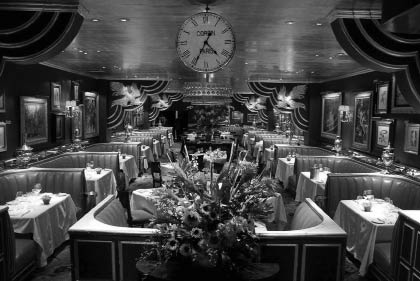In the fall of 1964, Roger Sterling tries to fix up the newly divorced Don Draper with twenty-five-year-old Bethany Van Nuys, a friend of Roger’s young second wife, Jane (“Mt. Holyoke. Gymnastics Team...If you hit it off, come Turkey Day maybe you can stuff her,” says Roger). Though Don tries to rebuff him, Roger tells Don’s secretary to make a reservation for “Beauty and the Beast” at Jimmy’s LaGrange. “They have Chicken Kiev,” Roger says to Don. “The butter squirts everywhere.” When they get to Jimmy’s, Bethany orders the Chicken Kiev, and Don makes it two.
Jimmy’s LaGrange is long gone, but it was a popular lunch spot for Madison Avenue ad men in the early 1960s. Its specialty was Chicken Kiev. Jimmy was Giulio Prigoni, an Italian-born musician who settled in New York. He often dispensed with menus and simply told customers—including Tony Bennett, Frank Sinatra, Gary Cooper, and Marilyn Monroe—what was for dinner. Jimmy would come to each table, draw Chicken Kiev (or the day’s special) on the tablecloth with a pencil, and give a short lecture on how it was prepared and how it should be “attacked” with knife and fork.
Jimmy added yet another of the myriad legends surrounding this sumptuous dish by telling diners that Chicken Kiev was invented by Napoleon’s chef during the march on Moscow. Winston Churchill once famously described Russia as “a riddle wrapped in a mystery inside an enigma,” not unlike matryoshka dolls, the wooden nesting dolls that are a popular Russian souvenir. The same can be said for Chicken Kiev; its origins are also a riddle wrapped in a mystery. The Russian Tea Room Cookbook (1981) by Faith Stewart-Gordon and Nika Hazelton calls it the “most famous…of all Russian dishes,” but acknowledges that its “Kievian origins are obscure and it seems most likely that Chicken Kiev was a creation of the great French chef Carême at the Court of Alexander I.” Add to this the fact that Kiev isn’t in Russia, but in neighboring Ukraine.
Other sources credit the Kiev style of poultry preparation to another French chef, Nicolas Appert (1749–1841), even though he didn’t call it Kiev. These sources posit that the Russian connection lies in the popularity of French cuisine among Russian royalty of the eighteenth century who often hired French chefs or sent their cooks to France to train. Still others say Kiev-style chicken wasn’t known in czarist times and is actually a Soviet-era innovation.
The style was often called “Supreme” in the United States, but it was New York restaurants, seeking to appeal to a large influx of Russian immigrants in the late nineteenth and early twentieth centuries, that first dubbed the preparation “Kiev.” After World War II, Chicken Kiev was a fixture in restaurants, such as the Russian Tea Room, that served fine Russian food.
The denizens of Madison Avenue would certainly have frequented this spot on West 57th Street, “slightly to the left of Carnegie Hall,” where they might have been seated at a table next to Rudolf Nureyev or Woody Allen. The Russian Tea Room is famous for its Chicken Kiev, a fixture on the menu since at least the 1940s. This dish is adapted from The Russian Tea Room Cookbook, which says its version of this classic is “generally acclaimed to be The Best.” How do you know when Chicken Kiev is properly prepared? The authors of The Russian Tea Room Cookbook authors concur with Roger: it’s “a spurt of butter at the first touch of knife and fork.”

THE DINING ROOM AT THE RUSSIAN TEA ROOM ON WEST 57TH STREET
ADAPTED FROM THE RUSSIAN TEA ROOM COOKBOOK BY FAITH STEWART-GORDON AND NIKA HAZELTON (RICHARD MAREK PUBLISHERS, 1981)
NOTE: The Russian Tea Room Cookbook offers two methods for cooking the chicken. One calls for frying the chicken and the other for baking the chicken. We offer both methods below.
The cookbook suggests serving Chicken Kiev over a bed of hot cooked rice, with buttered vegetables.
12 tablespoons sweet butter, chilled
6 chicken breast halves, tenderloins removed
3⁄4 teaspoon salt
3⁄4 teaspoon freshly ground black pepper
3 tablespoons all-purpose flour
2 eggs beaten
2⁄3–1 cup fine dry bread crumbs
Oil, for cooking chicken
Alternative method: Preheat oven to 350°F. Fry cutlets for 3 minutes, turning once. Place cutlets in a 13 x 9 x 2-inch baking pan and cook uncovered for about 15 minutes. Turn over twice while cooking using tongs or two spoons. Drain on paper towels before serving.
YIELD: 6 SERVINGS